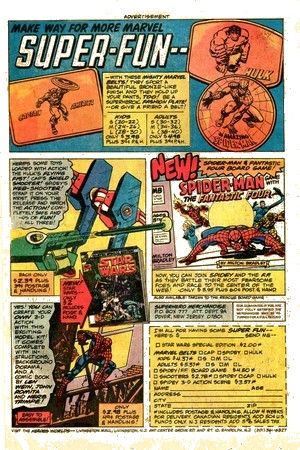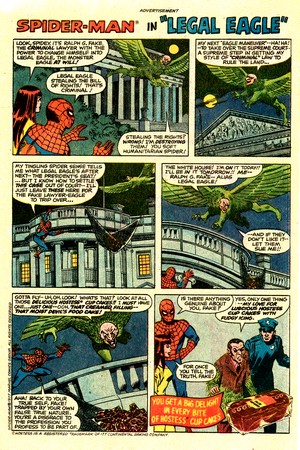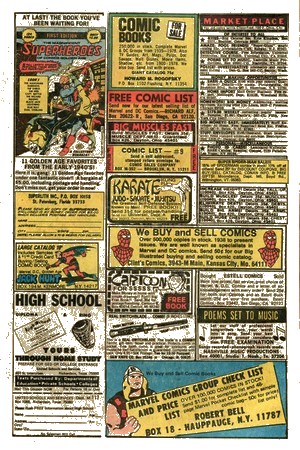 |
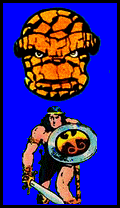 |
|
 SPOTLIGHT
ON SPOTLIGHT
ON
THE
THING, KULL & THE HUMAN FLY
INSIDE
A
DECEMBER
1977 MARVEL MULTI-MAGS
|
|
|
|
| |
MARVEL TWO-IN-ONE
#34
KULL THE
DESTROYER #24
HUMAN FLY #4
|
|
 |
|
| |
|

|
|
| |
| By the mid-1970s, Marvel had fully embraced the
marketing concept of selling multiple comic books
packaged in a sealed plastic bag to a customer
base in supermarkets and department store chains
which comic books could hardly reach otherwise. This example of a MARVEL MULTI-MAGS features three titles from
the December 1977 cover date run (meaning they
were actually on sale in September 1977):
Marvel Two-In-One #34, Kull the
Destroyer #24, and Human Fly #4.
Selling for 89¢, it was quite a bargain
compared to the newsagent total of $1.05 for the
same three comic books; earlier in the 1970s
comicpacks only sold for 1¢ less than the total of the
cover prices (however, sales tax at the
department store checkout would gobble up some of
that saving).
There
is no general rule to state what shape/grade the
comic books in a MARVEL MULTI-MAGS (or any
other comic pack for that matter) will be in.
During their 40+ years of storage, a lot of
things can go wrong. Some of these will only
affect the plastic bag, others might not harm the
packaging as much as the contents. As a result,
almost any combination is possible: you can have
a polybag displaying lots of wear but perfect
comic books inside (meaning it was mostly stored
in a dark and cool place but at some time took
some soiling or slight mechanical abrasion), but
you can just as well have a near pristine polybag
holding comic books showing substantial paper
degradation (indicating the bag was stored well
but exposed to light and excessive warmth for an
extended period of time).
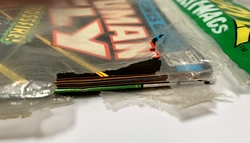 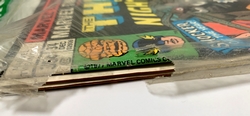
|
|
The
polybag of this December 1977 MARVEL
MULTI-MAGS is rather clean in
comparison to some packagings of the same
period, and also shows very little wear -
with the very noticeable exception,
however, of a large double tear which has
exposed, but not really damaged, the side
of the three comic books. This indicates
some sort of mechanical cause rather than
animals (especially rodents)
ripping/chewing the polybag open - which
is basically good news for the contents. However,
while the three comic books contained in
this polybag did not suffer any raw
physical damage (such as tears) as a
consequence of the plastic being torn,
some amount of humidity build-up or light
liquid-spillage must have taken place at
one point in time which affected the top
centre part of the two outer comic books.
|
As a result,
a slight wave on both the covers is visible as
well as some slight inside staining on the
central top area of the cover and the first page
of both Marvel
Two-In-One #34 and Human Fly #4. This is
however only really visible once the comics are
taken out of the polybag. The general rule
therefore is: if buying a comicpack is done in
the hope of acquiring high grade comic books with
no major blemishes, you might want to avoid
polybags which already display any visible
damage.
|
|
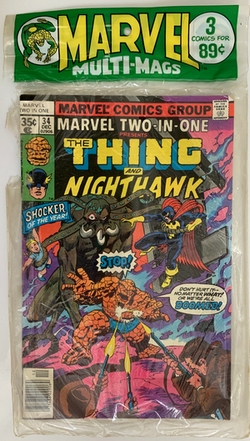 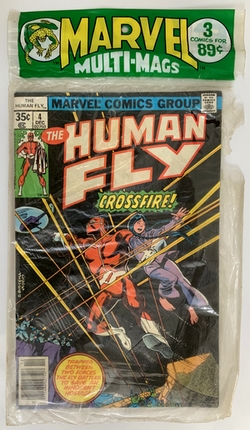
|
|
| |
| This mid-Bronze Age MARVEL MULTI-MAGS is a fairly standard example - issues
of Marvel Two-In-One, the Thing's team-up title,
were found regularly and often in MARVEL MULTI-MAGS, and several issues of both Kull
the Destroyer and Human Fly can be found
throughout Marvel's comicpacks of the mid- to late-1970s.
At face value, Marvel Two-In-One was a good
choice given that most issues featured episodic
done-in-one stories with the revolving door line-up of
the Thing's team-up partners - something which wasn't
exactly the case with either Kull the Destroyer or
the Human Fly. The continuity of the Marvel
Universe of the 1970s was such that storylines usually
evolved over more than one issue, so that having one
single issue of a title would possibly provide for an
entertaining read but also most likely end on a
cliffhanger - to be resolved in the next issue. Few (if
any) titles had permanent slots in the MARVEL MULTI-MAGS, however, so missing out on
the continuation of a storyline was highly probable. However, one needs to also bear in
mind that this was a common fate of the average comic
book reader in the 1970s Bronze Age, whether his or her
comic books came packaged in a plastic bag or as single
issues from a display or spinner rack. In those days, an
uninterrupted supply of specific titles simply was not
guaranteed, and one quickly became quite adept at not
feeling too worried over possible gaps in storylines. At
least you would usually get a recap of what had happened
so far on the first page. It simply was all a part of
being a comic book fan in the 1970s - just as the monthly
Bullpen Bulletins and in-house advertising were.
|
| |
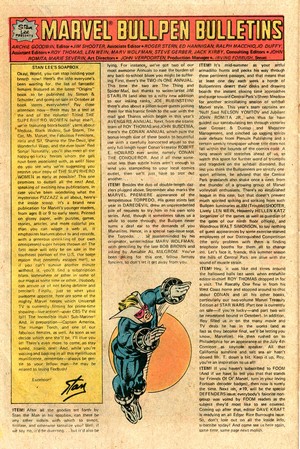 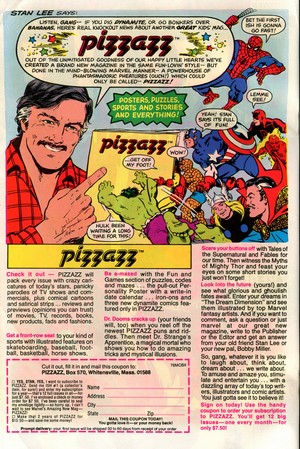 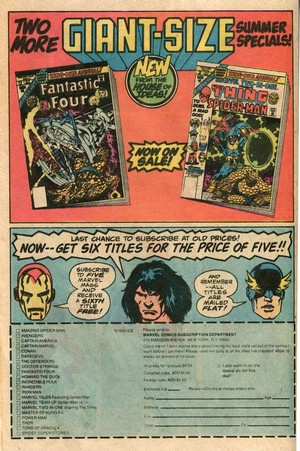 |
| |
| The Bullpen Bulletin for
the December 1977 cover date publication cycle was edited
by Archie Goodwin and featured the usual ITEM!
bullet points while also including Stan Lee's Soapbox,
all of which of course were frequently used to plug new
titles and products. |
| |
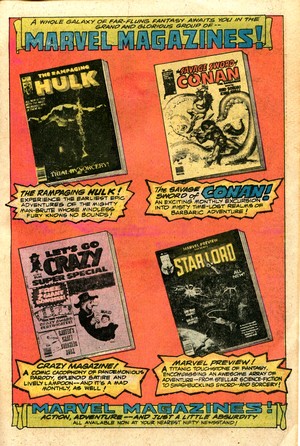
|
|
In
this case, Stan Lee was blowing the
trumpet for another upcoming Simon &
Schuster book (along the successful lines
of Origins of Marvel Comics and Bring
on the Bad Guys), this time
featuring The Superhero Women.
This was followed by another plug for Pizzazz,
"a brand new publication for
Marvel's younger readers, from ages 8 to
9 to early teens" (as Stan Lee
put it); it was also pushed by an
additional full page ad on the inside
cover of all three titles contained in
this MARVEL MULTI-MAGS (Pizzazz ran
from 1977 to 1979 for a total of 16
issues, featuring mostly articles about
popular movies and rock stars as well as
comic strips and puzzles). "After all
the goodies set forth by Stan the Man in
his soapbox, can there be any other
tidbits with which to tempt, titillate
and otherwise tantalize you?"
Archie Goodwin asked at the outset of the
first ITEM! bullet point, but of
course that was only a rhetorical
question as he went on to tell readers
about a handful of Annuals (Two-In-One,
Avengers and Conan) as
well as Torpedo's first solo appearance
in Marvel Premiere #39, rounded
off by mentionings of the House of Idea's
softball team and a visit to the Bullpen
by Roy Thomas (who had joined the growing
number of comic book creators moving out
to the West Coast by then) - no longer
referred to as "Roy the Boy"
(which most likely was Stan Lee's
privilege) but "Mr. T".
Two pages
were used in all three titles for placing
in-house advertisements (which Marvel
always used to great advantage to
sprinkle a little extra of their
incomparable House Style
throughout its comic books).
|
|
|
| |
| One such page devotes one
half to the usual subscription and the other half to "two
more Giant-Size Summer Specials on sale now" (riding
on the tail-end of summer, given that all three comic
books in this MARVEL
MULTI-MAGS went
on sale the first week of September), while the other
advertised four of Marvel's magazine-format publications. |
| |
| |
|
| |
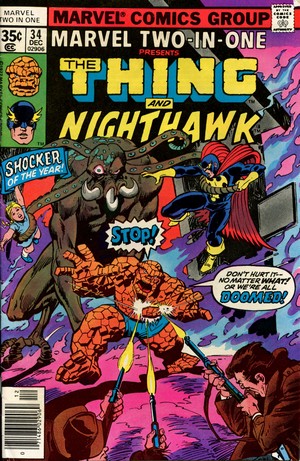
|
|
MARVEL
TWO-IN-ONE #34
December
1977
(monthly)
On Sale: 6 September 1977
Editor - Marv Wolfman
Cover - John Buscema (pencils) &
Klaus Janson (inks)
"A
Monster Walks Among Us!" (17 pages)
Story - Marv Wolfman
Pencils - Ron Wilson
Inks - Pablo Marcos
Lettering - Gaspar Saladino
(splashpage), Bruce Patterson
Colouring - Sam Kato
Synopsis
!
SPOILER ALERT !
Arriving
in his England branch as Nighthawk, Kyle
Richmond attends a board meeting where he
is shown a mysterious rock which seems to
contain something. Everybody agrees to
have it examined by Dr. Kort (who has
just succeeded in freeing Deathlok from a
villain named Mentallo's control and
turning the cyborg over to S.H.I.E.L.D.).
|
|
|
| |
| Upon examination of the
rock by Dr. Kort an alien creature breaks free and is
instantly hounded by people who consider it a menace.
However, when a local children's hospital catches fire,
the alien monster helps the Thing and Nighthawk save the
children trapped inside. In spite of this kind act, the
alien creature is shot dead by an ignorant local, leaving
Nighthawk and the Thing to ponder the wicked and ignorant
ways of the world. |
| |
| Although
it is highly doubtful that this was truly the "shocker
of the year" (as the cover blurb would
have it), Marvel Two-In-One #34 presents
a somewhat classic Marvel tale of morals: don't
judge people (and aliens) by their appearances.
It's a timeless theme, and Marv Wolfman does an
okay job with this one, even though the
consequences which the trigger-happy father of
one of the rescued kids has to face at the end
are rather more philosophical than real as
Nighthawk simply scolds him: "Monster?
You dare call
him a monster? He risked his life
to save your daughter. And all he was awarded
with -- was your abuse
-- and finally death!
Yeah, there's a monster
here -- but who's
the monster? Mister, who's the
monster?" Ron Wilson is the artist most
associated with the title due to his extended run
on pencils, and h's artwork fits in with the
story; while it does feature some slick panels,
it is mostly what could be called solid average.
|
|
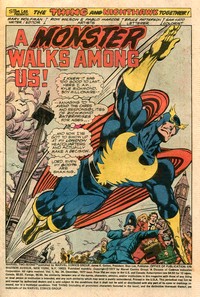 |
|
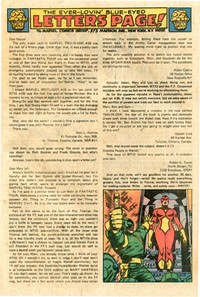 |
|
| |
| After successfuly trying
out the concept of teaming the Thing with a different
character for a done-in-one story in each issue of Marvel
Feature #11-12 (September and November 1973), Marvel
Two-in-One continued that team-up formula as of
January 1974. Clocking up a total of 100 issues between
then and June 1983 (plus seven Annuals along the way), it
was certainly one of Marvel's most successful team-up
titles and a fan favourite (and hence also featured a
regular letters page). Ideally suited for the comcipack
format due to it having a new storyline every issue, it
was a common title to be found in featured MARVEL MULTI-MAGS throughout the late 1970s
and very early 1980s right up until the demise of
Marvel's polybagged three- (and later two-) packs. |
| |
|
| |
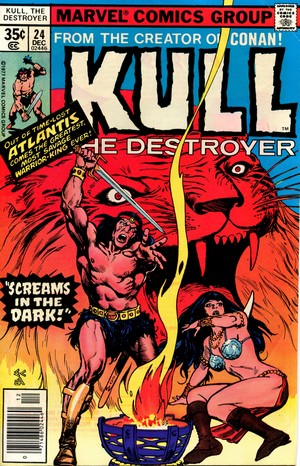
|
|
KULL
THE DESTROYER #24
December
1977
(bi-monthly)
On Sale: 6 September 1977
Editor - Roy
Thomas
Cover - Ernie Chan (pencils)
& Alfredo Alcala (inks)
"Screams
in the Dark!" (17 pages)
Story - Don
Glut
Pencils - Ernie Chan
Inks - Dino Castrillo
Lettering - Warren Greenwood
Colouring - Petra Goldberg
Synopsis
!
SPOILER ALERT !
As Kull
is struggling in the grasp of the
Demon-Shade it seems like all is
lost, but moments before it is
too late the barbarian manages to
break free and destroy the
outcropping that is causing the
shadow to exist. Unfortunately,
along with the demon the flower
for which Kull was fighting (and
which he was told could save the
life of fair lady Lorelei) has
also died and withered.
|
|
|
|
| |
| With nothing else to do
he heads back to a certain hunchback’s cottage, to
at least avenge her death, but instead finds her alive -
and the hunchback (who had previously threatened the lady
and tried to coerce her) with a sword in his chest.
Finding a map to the nearby city they both take off to
rescue Ridondo. After scaling the city walls they chance
upon a wizard whom Kull forces to tell them the
whereabouts of Ridondo - who, it turns out, is held
captive in the dungeon. Racing to free him, Kull
discovers a giant snake guarding the prisoner... As is quite clear from the synopsis,
this storyline is continued from the previous issue of Kull
the Destroyer (as an editorial asterisk on the
splashpage was wanting to indicate, but somehow the
textbox with the reference for this got lost...), making
this a good example of the problematic aspects of many
titles contained in MARVEL MULTI-MAGS already mentioned - you
simply got thrown into (and out of) the plot, with characters and their
roles more (or less) explained - and no guarantee
whatsoever of finding the next issue in a MARVEL MULTI-MAGS.
Kull was created by Robert
E. Howard and preceded his popular sword and sorcery hero
Conan the Barbarian - in fact, Conan's first appearance
was a rewriting of an earlier Kull story (Byrne, 2019).
|
| |
| Following Marvel's success
with Conan the Barbarian (launched in
October 1970 and ultimately running for a total
275 issues until December 1993), Kull was
introduced as "King Kull" in Creatures
on the Loose #10 (March 1971) before getting
his own title, Kull the Conqueror, in June
1971 - although his publishing history at Marvel
was far less successful and far more complicated
than Conan's. During a hiatus from October 1971
to June 1972 (between issues #2 and #3 of Kull
the Conqueror), he featured (again
as "King Kull") in Monsters on the
Prowl #16 (April 1972). Once the title picked
up again, Kull the Conqueror changed its
name to Kull the Destroyer as of issue #11
(November 1973) and ran up to issue #29 (October
1978) - but not without yet another publishing
hiatus from September 1974 to July 1976, between
issues #15 and #16. Sword and sorcery was one of
Marvel's first forays into a genre outside of
superheroes and sci-fi-horror as the House of
Ideas sought to diversify and expand its market
reach at the outset of the 1970s, and it proved a
successful one (although thanks mainly to Conan
and less so to Kull). Despite the rather
chequered publivation history, a number of Kull
titles made it into some MARVEL MULTI-MAGS - although nowhere near as
many as the sword and sorcery flagship Conan
the Barbarian.
|
|
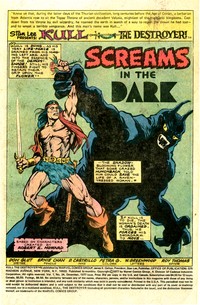 |
|
| |
| Possibly a reflection of
the somewhat stop-and-go publication of the title, Kull
the Destroyer #24 featured no letters page. But then
the Atlantean king only had five more issues to go before
cancellation. |
| |
|
| |
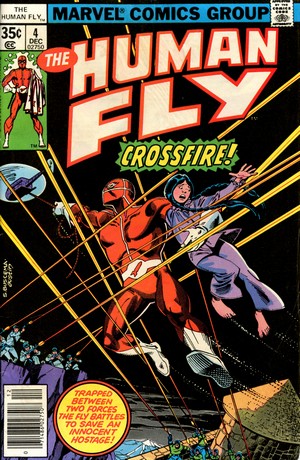
|
|
HUMAN
FLY #4
December
1977
(monthly)
On Sale: 6 September
1977
Editor
-Archie Goodwin
Cover - Sal Buscema (pencils)
& Terry Austin (inks)
"Rocky
Mountain Nightmare!" (17
pages)
Story - Bill
Mantlo
Pencils - Lee Elias
Inks - Rod Santiago
Lettering - Denise Wohl
Colouring - George Roussos
The superhero
Human Fly (there was a Spider-Man
villain by the same name too) was
a somewhat special Marvel
character as he was supposedly
based on real-life stuntman Rick
Rojatt (who actually was but one
in a whole row of stuntmen to
call himself the "Human
Fly" throughout the 20th century).
Consequently,
most covers (though not this one)
of Human Fly carried the
tag line "The Wildest
Super-Hero Ever –
Because He's Real!"
|
|
|
|
| |
| Creator
Bill Mantlo turned this basic starting concept
into the story of a young man who is severely
injured during a car crash but - after a lengthy
period of hospitalization and a number of
reconstructive surgeries during which much of his
skeleton is replaced by steel - takes on a masked
identity and calls himself the Human Fly. In this
guise, he performs a slew of daredevil stunts
(using his enhanced physical abilities (some
stemming from his partly metal skeleton) and a
number of specialised equipment) to benefit
various charities, especially those helping
children with disabilities. However, his
activities often put him in the way of criminals
- who more often than not plan to rob the charity
events at which he performs. It was, to put it kindly,
very formulaic and very cheesy even by late 1970s
standards, but Marvel pushed Human Fly
#1 in September 1977 in a big way with lots and
lots of in-house advertising and Bullpen Bulletin
shoutouts. Human Fly did manage to clock
up a few issues before cancellation, which hit
after Human Fly #19 (March 1979).
|
|
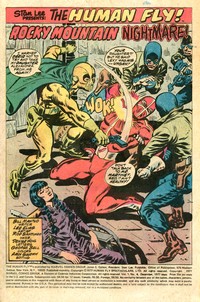 |
|
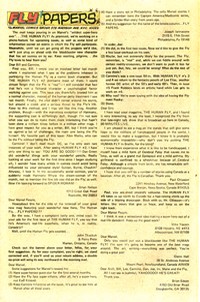 |
|
| |
According to Jim Shooter,
the concept was thrust upon editorial staff by "someone
upstairs":
"Probably
someone in our licensing department met the Fly's
licensing folks at a trade show and convinced the
president of the company [i.e. Marvel] that
it was a good idea - without consulting us."
(Aushenker, 2007)
Issues of Human Fly
appeared in MARVEL
MULTI-MAGS quite often
and regularly, and judging from the letters printed in
the issue contained in this December 1977 Multi-Mag, the
character did enjoy some initial popularity amongst
readers. From a retrospective (and more adult)
perspective, however, far too many aspects of Bill
Mantlo's character concept don't really work (Calamity,
2007).
PS. There's a 1976 CBC
portrait of "philanthropic daredevil" Rojatt
wearing his "Human Fly" outfit and explaining
his plans and motivation on youtube.
|
| |
|
| |
| No 1970's Marvel comic book
was, of course, without third party advertising, some of
which was "okay" (mostly if it featured Marvel
characters) and some of which was, well, something else
(such as the infamous flea market ads promising anything
and everything). All three titles included in this
December 1977 Multi-Mag carried exactly the same ads,
illustrated here, and it is interesting to note that by
1977 more and more outlets selling comic book back issues
advertised in these pages. |
| |
|
| |
|
| |
| BIBLIOGRAPHY AUSHENKER Michael
(2007) "The Human Fly: Pretty Fly for a Real
Guy", in Back Issue #20
BYRNE Bob
(2019) "Hither Came Conan: Ruminations of
"The Phoenix on the Sword", published online for Black
Gate, 22 January 2019
CALAMITY
Jon (2007) "Classic Gone-And-Forgotten: The Human
Fly". published
online for Ape Law, 13 October 2007 (via archive.org)
|
| |
|
| |
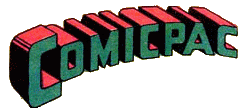
More on comic
packs
|
| |
|
| |

(c) 2020
uploaded to the web 1
August 2020
|
| |
|
| |
|





 SPOTLIGHT
ON
SPOTLIGHT
ON













